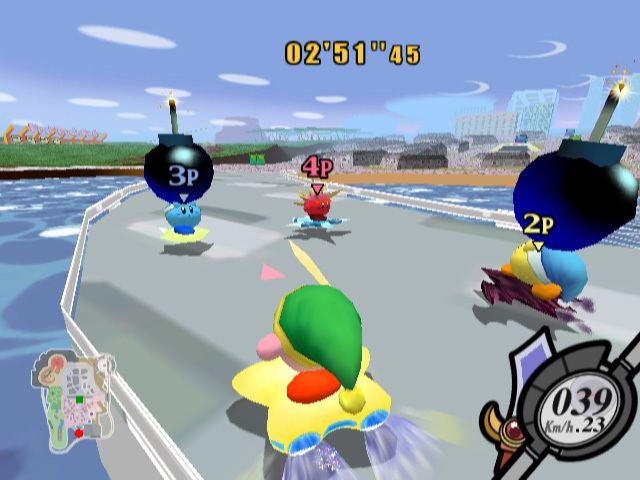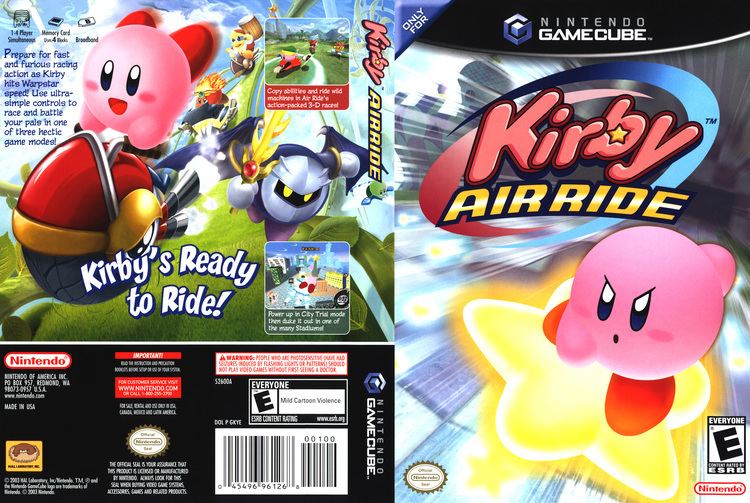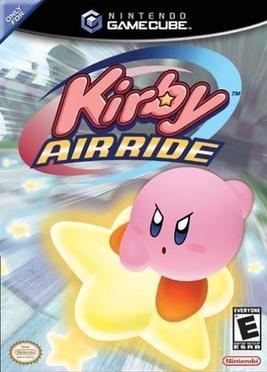6.8 /10 1 Votes
61% Metacritic Initial release date 11 July 2003 | 4.5/5 Emuparadise 5.2/10 IGN Artist(s) Kazuya Konishi Genre Racing video game | |||||||||||||||||||||||||||||||||
 | ||||||||||||||||||||||||||||||||||
Producer(s) Hiroaki SugaMasayoshi TanimuraShigeru Miyamoto Composer(s) Shogo SakaiJun IshikawaHirokazu AndoTadashi Ikegami Similar Kirby games, Masahiro Sakurai games, Racing video games | ||||||||||||||||||||||||||||||||||
Kirby air ride push a part 1 game grumps vs
Kirby Air Ride, known in Japan as Kirby's Airride (カービィのエアライド, Kābī no Earaido), is a 2003 racing game video game developed by HAL Laboratory and published by Nintendo for the GameCube video game console starring Kirby, one of HAL's characters.
Contents
- Kirby air ride push a part 1 game grumps vs
- Kirby air ride dragoon and hydra
- Gameplay
- Air Ride
- Top Ride
- City Trial
- Development
- Music
- Reception
- Legacy
- References

Kirby Air Ride has the players and computer-controlled racers ride on Air Ride Machines. The game supports up to four players, and was the first GameCube title to support LAN play using broadband adapters and up to four GameCube systems.

Air Ride received a mixed reception from critics, who criticized the game's simplicity. However, the game was a commercial success, selling over 1.2 million copies worldwide.

Kirby air ride dragoon and hydra
Gameplay
Kirby Air Ride is played primarily through use of a vehicle, many of which are taken from previous Kirby games, such as the Warpstar. Players take control of Kirby or any of his multicolored counterparts to compete in races or other minigames.
The simple controls are a defining feature of Kirby Air Ride. Unlike most racers, no input is necessary for the craft to move forward. Other than the use of the Control Stick to steer, the A button performs all other actions in the game, including braking, charging up for a boost, sucking in nearby enemies and thereafter using the powers absorbed from them. Gliding is also a definitive feature of the game, as the player can control the crafts' altitude when they go airborne.
Each of the three modes of the game has a "checklist" associated with it. These are 12x10 grids which contain 120 squares, all of which are initially blank. Each square has a hidden goal contained inside it, and certain goals also have unlockable content attached to them, such as alternate machines, new items and courses, new characters, and music tracks for the sound test. When a goal is completed, the squares fill to reveal completed goals. In practice, this system of discovering unknown goals is balanced out by several goals which are relatively easy to obtain, such as "finish a race three times" or "race on every course," and various other goals which only require the accrual of play time; these, in turn, make it easier to find out what other, more specific goals are, since each goal unlocked will open up the objective of the goals touching the goal completed.
Kirby is the only playable character available from the start of the game, and the only one who can ride different machines and suck up enemies to copy their abilities. Multiple players are represented by different colors of Kirby. Meta Knight, Kirby's rival, is an unlockable character. He doesn't ride machines, but instead uses his wings to float above the ground. He controls like a combination of Wing Kirby and Sword Kirby, as he uses sword attacks automatically when he approaches enemies or other players. Because he has high speed and acceleration in the game, he cannot charge. King Dedede is also unlockable. Controlling him is almost exactly like using the Wheelie Bike, except he can attack automatically with his hammer, similar to Meta Knight's attack.
Air Ride
Air Ride is a basic, back-view racing mode. The player chooses a racing machine and races against up to three other human or computer players via split-screen or LAN to get to the finish before anyone else. There are two ways to play a typical Air Ride race:
In both modes, the Kirbys may swallow and acquire the abilities of enemies strewn along the track and use those powers against their rivals. Doing so will slow Kirby's enemies down and potentially do damage to them (if the Health Bar is activated for the race.)
In addition to the racing mode, Air Ride also has the option of Time Attack mode, where a single player races around a track for three laps. Lastly, a single player can also race Free Run mode, an endless race with the sole purpose of reaching the fastest possible Lap Time.
Top Ride
Top Ride is a racing mode on smaller, simpler tracks, and is viewed from above the track. Due to the decreased track size, the default number of laps is increased per track. Top Ride has only two vehicles to choose from; the red Free Star moves in the direction the Control Stick is tilted, while the blue Steer Star rotates clockwise or counterclockwise based on tilting the Control Stick right or left.
Like Air Ride, Top Ride also has Time Attack and Free Run modes. There are seven courses total, based on seven different themes: Grass, Sand, Sky, Fire, Light, Water and Metal.
City Trial
City Trial is a larger mode where players must navigate a city, along with several more sections such as a forest, cave, and volcano, while grabbing Air Ride machine upgrade items, such as boosts, top speeds, charges, offense, defense, and more. Various Air Ride vehicles are randomly scattered throughout the city, allowing the player to switch vehicles at any time in the game. Players can even collect rare machine pieces to fuse together into "Legendary Machines". This mode also features random events such as falling meteors, UFOs, Dyna Blade, rail station fires, bouncing items, fake power-ups, a strange pillar, a thief, all boxes containing the same items, dense fog, and more. When time expires, players face off in a small competition that tests how well your machine ended up, which can vary between a drag race, a brawl, a contest to destroy the most enemies, a gliding game, and even a lap on one of the Air Ride courses.
Development
Kirby Air Ride (known as Kirby's Air Ride at the time) was originally in development during the early days of the Nintendo 64 video game console. It was one of only two playable demos shown at the Nintendo 64's unveiling at the 1995 Shoshinkai show (the other being Super Mario 64). At this point the game was somewhat similar to Marble Madness, as players would control a ball-shaped Kirby to either race across an obstacle course (in single player) or knock competing players off the playing field (in multiplayer). It went through many changes during its elongated development period before eventually being canceled and then resurfacing on the GameCube in the form of a short video preview in March 2003 at the annual DICE summit in Las Vegas, at which point it received its final title. This preview received a mainly negative reception due to slow speeds and poor graphics, which led to the cancellation.
Kirby Air Ride was first seen in playable form at E3 in May later that year. The demo contained five playable tracks and three different game modes. The reception to the playable demo was more positive than they were from previous showings.
Masahiro Sakurai, the game designer behind most of the early games in the Kirby series, resigned from his position at HAL Laboratory shortly after the game's release, citing that he was tiring of the constant pressure from the industry to keep creating sequels.
Music
The soundtrack was composed by Shogo Sakai, Jun Ishikawa, Hirokazu Ando, and Tadashi Ikegami. These same composers also worked on Super Smash Bros. Melee.
Kirby Air Ride features songs from the Japanese version of Kirby: Right Back at Ya! (the game was also advertised at the end of some episodes).
Reception
Kirby Air Ride sold 422,311 copies in Japan and 750,000 in the United States. Upon its release, it received "mixed" reviews according to the review aggregation website Metacritic. Most websites and magazines praised its clean presentation and the originality of the City Trial mode while criticizing its gameplay as being overly simple. Kirby Air Ride's similarity to other titles released for the GameCube around the same time (most notably F-Zero GX and Mario Kart: Double Dash!!, both of which were also made by Nintendo) resulted in it being categorized as a rather throwaway title. In Japan, Famitsu gave it a score of two eights and two nines for a total of 34 out of 40.
Legacy
Oddly enough, Super Smash Bros. Melee had an event called "Kirby's Air-raid", which might reference Kirby Air Ride despite Melee being released in 2001 and Kirby Air Ride being released 2 years later.
The game features a checklist format that is later used in the "Challenges" section of Super Smash Bros. Brawl as well as the "Treasure Hunt" section of Kid Icarus: Uprising. Super Smash Bros. for Nintendo 3DS features an exclusive mode called Smash Run that is based on the concept for City Trial mode.
